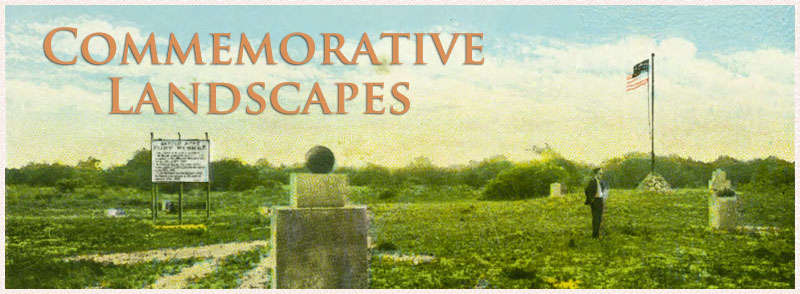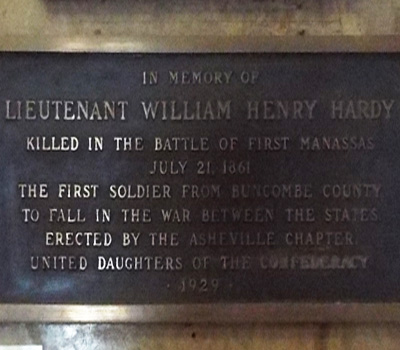
William Henry Hardy Plaque, Asheville
The memorial to Lieutenant Hardy is a simple bronze plaque about 12 inches high by 24 inches wide attached to a wall between several elevators in the lobby of the old historic section of the Buncombe County Courthouse.
Images:
Far-off view of the plaque
IN MEMORY OF / LIEUTENANT WILLIAM HENRY HARDY / KILLED IN THE BATTLE OF FIRST MANASSAS / JULY 21, 1861 / THE FIRST SOLDIER FROM BUNCOMBE COUNTY / TO FALL IN THE WAR BETWEEN THE STATES. / ERECTED BY THE ASHEVILLE CHAPTER / UNITED DAUGHTERS OF THE CONFEDERACY / 1929
Buncombe County
February 8, 1930
35.595980 , -82.548640
View in Geobrowse
"Buncombe County Court House, Asheville, N.C." in Durwood Barbour Collection of North Carolina Postcards (P077), North Carolina Collection Photographic Archives, Wilson Library, UNC-Chapel Hill. Link
"Buncombe County Court House, Asheville, N.C." in Durwood Barbour Collection of North Carolina Postcards (P077), North Carolina Collection Photographic Archives, Wilson Library, UNC-Chapel Hill. Link
“Entwined With Slavery: A Brief Local History,” Smoky Mountain News (Waynesville, NC), July 8, 2020, smokymountainnews.com, (accessed May 1, 2023) Link
“Memory of Buncombe Hero Will Be Honored,” Asheville Citizen-Times (Asheville, NC), January 29, 1930
“To Unveil Memorial for Lieut. Hardy Tomorrow,” Asheville Citizen-Times (Asheville, NC), February 7, 1930
Yes
Bronze
Asheville Chapter United Daughters of the Confederacy
The presentation address was made by Mrs. A. Matthews on behalf of the Asheville Chapter of the U.D.C. and the plaque unveiled by Miss Harriette Taylor Tennent a grand-niece of Lieutenant Hardy from Spartanburg, S.C. The plaque was accepted on behalf of Asheville by Mayor Gallatin Roberts, on behalf of Buncombe County by Newton M. Anderson and on behalf of the State Division U.D.C. by Mrs. E.L. McKee.
[Additional information from NCpedia editors at the State Library of North Carolina: This person enslaved and owned other people. Many Black and African people, their descendants, and some others were enslaved in the United States until the Thirteenth Amendment abolished slavery in 1865. It was common for wealthy landowners, entrepreneurs, politicians, institutions, and others to enslave people and use enslaved labor during this period. To read more about the enslavement and transportation of African people to North Carolina, visit https://aahc.nc.gov/programs/africa-carolina-0. To read more about slavery and its history in North Carolina, visit https://www.ncpedia.org/slavery. - Government and Heritage Library, 2023.]
The plaque was manufactured in New York City.
The plaque can be found in the lobby of the old 1927 section of the Buncombe County Courthouse, at College St. and Court Plaza, Asheville, NC. To access this lobby one must enter through the modern entrance facing College Street. On the same wall as Hardy’s plaque is one to Col. Edward Buncombe. In the immediate area of the old Buncombe County Courthouse there are other notable plaques, monuments and memorials: Western North Carolina Veterans Memorial, 60th NC Regiment, Revolutionary War, Spanish American and other wars, Police and Firemen who died in the line of duty, Medal of Honor recipient Lt. Colonel Robert Morgan and former Governor Samuel Ashe for whom Asheville was named. Several hundred yards to the west stands the monument to Zebulon Vance and several other small markers.
The memorial plaque is in the lobby of the old historic section of the Buncombe County Courthouse.
 Know anything else about this monument that isn't mentioned here? If you have additional information on
this or any other monument in our collection fill out the form at the Contact Us link in the footer. Thank you.
Know anything else about this monument that isn't mentioned here? If you have additional information on
this or any other monument in our collection fill out the form at the Contact Us link in the footer. Thank you.

